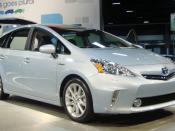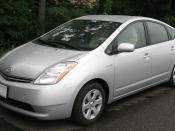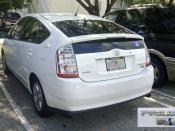1
Abstract
The unpredictable success of Toyota in introducing its Hybrid car, PRIUS, made it
a good example and a very important case to study by marketers and managements. In
this paper we try to spot a light on all, micro and macro, environmental factors surround
the introduction of the PRIUS in U.S market. We try to analyze the marketing strategies
taken by Toyota's marketing managers to lead the market of Hybrids in the U.S and to
dominate Hybrids market share.
Introduction
In 2001, Toyota decided to enter the US market with a brand new technology
used in vehicles, the Hybrids. Toyota was not the first company decided to enter the U.S
market, Honda preceded Toyota in 1999 and introduced its Hybrid car to the U.S
market. Considering the behavior and the expectations of American consumers, Toyotas
executives were not motivated to introduce such a technology to U.S market, and
described it as a risky adventure to take.
After the successful introduction of Honda's Hybrid vehicle, Toyota decided to
introduce the 2001 PRIUS to the market. The PRIUS combines two engines, gas and
electrical in order to strengthen fuel and power efficiency. It runs on only the electrical
engine at start up until it reach specific speeds it turned to the gas engine. The first
generation of PRIUS with a 2001 model introduced in 2000, same model produced in
Japan, with a total 114 HP was a boring Asian design as seen by American consumers.
Toyota enhanced the new generations of PRIUS in interior design, power, luxury touches
and fuel efficiency to meet demands. After all enhancement Toyota inserted in PRIUS,
consumers started to like the new improvements, and according to that, PRIUS sales
peaked to a significant numbers starting with moderate sales of 15,000 units of the first...


